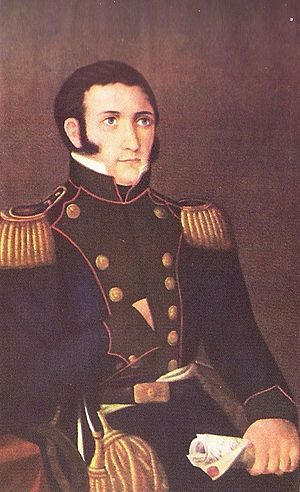Manuel Dorrego facts for kids
Quick facts for kids
Manuel Dorrego
|
|
|---|---|
 |
|
| Interim Governor of Buenos Aires Province | |
| In office 29 June 1820 – 20 September 1820 |
|
| Preceded by | Miguel Estanislao Soler |
| Succeeded by | Martín Rodríguez |
| Governor of Buenos Aires Province | |
| In office 13 August 1827 – 1 December 1828 |
|
| Preceded by | Juan Gregorio de Las Heras |
| Succeeded by | Juan Lavalle |
| Personal details | |
| Born | 11 June 1787 Buenos Aires, Viceroyalty of the Río de la Plata, Spanish Empire |
| Died | 12 December 1828 (aged 41) Navarro, United Provinces of the Río de la Plata |
| Resting place | La Recoleta Cemetery |
| Nationality | Argentine |
| Political party | Federal |
| Alma mater | Real Universidad de San Felipe |
| Profession | Military |
| Military service | |
| Allegiance | United Provinces of the Río de la Plata |
| Unit | Army of the North |
| Battles/wars | Second Upper Peru campaign |
Manuel Dorrego (born June 11, 1787 – died December 13, 1828) was an important Argentine leader. He was a soldier and a statesman. He served as the governor of Buenos Aires twice. First in 1820, and then again from 1827 to 1828.
Contents
Early Life and Education
Manuel Dorrego was born in Buenos Aires on June 11, 1787. His father, José Antonio do Rego, was a merchant from Portugal. His mother was María de la Ascensión Salas.
He started his studies at the Real Colegio de San Carlos in 1803. Later, he moved to Chile to study at the Real Universidad de San Felipe. While there, he supported Chile's fight for independence from Spain in 1810.
Military Career and Political Ideas
Dorrego later moved to the United Provinces of the Río de la Plata. This area is now modern Argentina. He joined the Army of the North, which was led by Manuel Belgrano.
He fought bravely in two important battles: the Battle of Tucumán and the Battle of Salta. He was injured in both of these fights. He was known for being a strong and sometimes rebellious soldier.
Exile and Federalism
Dorrego disagreed with some powerful leaders of his time. He opposed the invasion of the Banda Oriental (modern Uruguay) by forces from Brazil and Portugal. This invasion was supported by Juan Martín de Pueyrredón, a key Argentine leader.
Because of his strong opinions, Pueyrredón sent Dorrego into exile. Dorrego spent some time in Baltimore, United States. While there, he learned about a system of government called federalism.
Federalism means that different states or regions within a country have some power and control over their own affairs. This was different from the idea of a very strong, single central government that many leaders in Argentina wanted. Dorrego believed that each part of the country should have more freedom.
During his exile, he wrote a book called Cartas apologéticas. In this book, he openly criticized Pueyrredón's support for the Luso-Brazilian invasion.
Return to Politics and Governorship
Dorrego returned to Buenos Aires in 1819 after Pueyrredón left power. He was chosen to be the temporary governor. He faced many challenges, including fighting against other military leaders.
However, he faced resistance in the city. So, Martín Rodríguez was chosen as the official governor instead of Dorrego. Dorrego was then sent away again, this time to Upper Peru (modern Bolivia). He even met Simón Bolívar in Quito. Bolívar was a famous leader who wanted to unite all of South America into a large federation.
Working for a Federal System
Dorrego soon returned to Buenos Aires. He became a member of the legislature in 1826. This group was creating a new constitution for Argentina. Dorrego strongly believed in a federal system of government. He also disagreed with the idea that only wealthy people should be allowed to vote.
However, the Argentine Constitution of 1826 created a very strong central government. It also kept the rule that only certain people could vote.
Dorrego opposed the government of Bernardino Rivadavia, who became the first president of Argentina. Dorrego shared his criticisms in a newspaper called "El Tribuno".
Governor of Buenos Aires Again
Rivadavia faced a lot of opposition from different provinces and eventually resigned as president. The vice president also resigned. With no national leader, the legislature chose Dorrego to be the governor of the Buenos Aires province.
As governor, Dorrego took steps to help poor people. He also worked to create a federal organization for the country. One of his most important actions was ending the Argentine–Brazilian War.
Downfall and Legacy
The Argentine soldiers were not happy with Dorrego. They felt he accepted unfair conditions to end the war, even though they had won many battles. The Unitarian party, which favored a strong central government, encouraged Juan Lavalle to act.
Lavalle led a military takeover against Dorrego on December 1, 1828. This is known as the Decembrist Revolution. Dorrego left the city and tried to gather his own forces in the countryside.
However, Dorrego was defeated. He was then executed by Lavalle. After this, Lavalle closed the legislature and started a period of political violence against the Federales, Dorrego's supporters. But Lavalle was later defeated by Juan Manuel de Rosas. Rosas then brought back the political system that existed before Lavalle's takeover.
See also
 In Spanish: Manuel Dorrego para niños
In Spanish: Manuel Dorrego para niños
- Argentine Civil War
- Manuel Dorrego national institute


